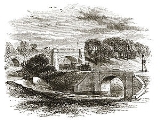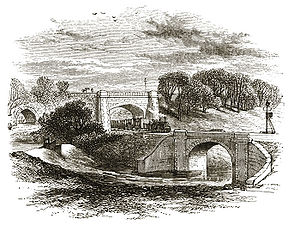
Bullbridge
Encyclopedia
Bullbridge is a small village in Derbyshire
. The Bull bridge accident
happened here in 1860.
) and the Lord Nelson .
Until the end of the eighteenth century it was little more than the bridge over the River Amber
for the road from Crich
.
In 1794, William Jessop
and Benjamin Outram
built the Cromford Canal between Cromford
and Langley Mill
, with the Bullbridge Aqueduct
crossing the road. In 1840, George Stephenson
brought the North Midland Railway
past on its way to Leeds
crossing the road, but passing under the canal.
 In 1860 the railway bridge failed as a goods train passed over it, fortunately without casualties.
In 1860 the railway bridge failed as a goods train passed over it, fortunately without casualties.
The steep wagonway
to the Cromford Canal
from the quarry at Crich
to Bullbridge, where limestone
was sent on to the Butterley Ironworks
was known as the Butterley Gang Road. Initially worked by gravity and horse power, in 1812, William Brunton, an engineer for the company, produced his remarkable Steam Horse locomotive
. They built a wharf for loading the limestone
from their quarry at Crich, and a group of lime
kilns.
In 1825 James Stephenson founded a dye works at Wirksworth
opening branches in Duffield and Little Eaton
, then Belper
, finally building his main works at Bullbridge in 1908. The works became part of Coats plc and closed at the end of 2006.
Hilt's Quarry and the gangway closed in 1933 and is now derelict, the canal having already been virtually closed by the subsidence of Butterley Tunnel..
Derbyshire
Derbyshire is a county in the East Midlands of England. A substantial portion of the Peak District National Park lies within Derbyshire. The northern part of Derbyshire overlaps with the Pennines, a famous chain of hills and mountains. The county contains within its boundary of approx...
. The Bull bridge accident
Bull bridge accident
The Bull bridge accident was a failure of a cast-iron bridge at Bullbridge, near Ambergate in Derbyshire on 26 September 1860. As a goods train was passing over the bridge at Bullbridge, the structure failed suddenly, causing the derailment of the majority of the wagons...
happened here in 1860.
The village
Bullbridge has a population of approx. 220 and is served by two public houses - the Canal Inn, (after the Cromford CanalCromford Canal
The Cromford Canal ran 14.5 miles from Cromford to the Erewash Canal in Derbyshire, England with a branch to Pinxton. Built by William Jessop with the assistance of Benjamin Outram, its alignment included four tunnels and 14 locks....
) and the Lord Nelson .
Until the end of the eighteenth century it was little more than the bridge over the River Amber
River Amber
The River Amber is a river in Derbyshire, England which rises close to the village of Ashover, near Clay Cross, and flows southwards through Ogston Reservoir to Pentrich then westwards to join the River Derwent at Ambergate...
for the road from Crich
Crich
Crich is a village in Derbyshire in England. It has the National Tramway Museum inside the Crich Tramway Village, and at the summit of Crich Hill above, a Memorial Tower for those of the Sherwood Foresters regiment who died in battle, particularly in World War I.Built in 1923 on the site of an...
.
In 1794, William Jessop
William Jessop
William Jessop was an English civil engineer, best known for his work on canals, harbours and early railways in the late 18th and early 19th centuries.-Early life:...
and Benjamin Outram
Benjamin Outram
Benjamin Outram was an English civil engineer, surveyor and industrialist. He was a pioneer in the building of canals and tramways.-Personal life:...
built the Cromford Canal between Cromford
Cromford
Cromford is a village, two miles to the south of Matlock in the Derbyshire Dales district in Derbyshire, England. It is principally known for its historical connection with Richard Arkwright, and the Cromford Mill which he built here in 1771...
and Langley Mill
Langley Mill
Langley Mill is a small town in the Amber Valley district of Derbyshire, England. It is on the border of Nottinghamshire, and runs into the towns of Aldercar and Heanor . Across the River Erewash is the Nottinghamshire town of Eastwood. It is part of the Aldercar and Langley Mill parish....
, with the Bullbridge Aqueduct
Bullbridge Aqueduct
The Bull Bridge Aqueduct was situated on the Cromford Canal, built in 1794, at Bullbridge east of Ambergate along the Amber Valley where it turned sharply to cross the valley and the Ambergate to Nottingham road...
crossing the road. In 1840, George Stephenson
George Stephenson
George Stephenson was an English civil engineer and mechanical engineer who built the first public railway line in the world to use steam locomotives...
brought the North Midland Railway
North Midland Railway
The North Midland Railway was a British railway company, which opened its line from Derby to Rotherham and Leeds in 1840.At Derby it connected with the Birmingham and Derby Junction Railway and the Midland Counties Railway at what became known as the Tri Junct Station...
past on its way to Leeds
Leeds
Leeds is a city and metropolitan borough in West Yorkshire, England. In 2001 Leeds' main urban subdivision had a population of 443,247, while the entire city has a population of 798,800 , making it the 30th-most populous city in the European Union.Leeds is the cultural, financial and commercial...
crossing the road, but passing under the canal.

The steep wagonway
Wagonway
Wagonways consisted of the horses, equipment and tracks used for hauling wagons, which preceded steam powered railways. The terms "plateway", "tramway" and in someplaces, "dramway" are also found.- Early developments :...
to the Cromford Canal
Cromford Canal
The Cromford Canal ran 14.5 miles from Cromford to the Erewash Canal in Derbyshire, England with a branch to Pinxton. Built by William Jessop with the assistance of Benjamin Outram, its alignment included four tunnels and 14 locks....
from the quarry at Crich
Crich
Crich is a village in Derbyshire in England. It has the National Tramway Museum inside the Crich Tramway Village, and at the summit of Crich Hill above, a Memorial Tower for those of the Sherwood Foresters regiment who died in battle, particularly in World War I.Built in 1923 on the site of an...
to Bullbridge, where limestone
Limestone
Limestone is a sedimentary rock composed largely of the minerals calcite and aragonite, which are different crystal forms of calcium carbonate . Many limestones are composed from skeletal fragments of marine organisms such as coral or foraminifera....
was sent on to the Butterley Ironworks
Butterley Company
Butterley Engineering was an engineering company based in Ripley, Derbyshire. The company was formed from the Butterley Company which began as Benjamin Outram and Company in 1790 and existed until 2009.-Origins:...
was known as the Butterley Gang Road. Initially worked by gravity and horse power, in 1812, William Brunton, an engineer for the company, produced his remarkable Steam Horse locomotive
Steam Horse locomotive
The Steam Horse was constructed by the Butterley Company in Derbyshire in 1813 by William Brunton . Also known as the "Mechanical Traveller" it had a pair of mechanical legs, with feet that gripped the rails at the rear of the engine to push it forwards at about three miles an hour.-Design:To...
. They built a wharf for loading the limestone
Limestone
Limestone is a sedimentary rock composed largely of the minerals calcite and aragonite, which are different crystal forms of calcium carbonate . Many limestones are composed from skeletal fragments of marine organisms such as coral or foraminifera....
from their quarry at Crich, and a group of lime
Lime (mineral)
Lime is a general term for calcium-containing inorganic materials, in which carbonates, oxides and hydroxides predominate. Strictly speaking, lime is calcium oxide or calcium hydroxide. It is also the name for a single mineral of the CaO composition, occurring very rarely...
kilns.
In 1825 James Stephenson founded a dye works at Wirksworth
Wirksworth
Wirksworth is a small market town in Derbyshire, England, with a population of over 9,000.The population of the Wirksworth area including Cromford, Bolehill and Middleton-by-Wirksworth is about 12,000. Wirksworth is listed in the Domesday Book in 1086. Within it is the source of the River...
opening branches in Duffield and Little Eaton
Little Eaton
Little Eaton is a village in the English county of Derbyshire. The name originated from Anglo Saxon times and means the little town by the water....
, then Belper
Belper
Belper is a town and civil parish in the local government district of Amber Valley in Derbyshire, England.-Geography:Belper is situated eight miles north of Derby and is centred in the valley of the River Derwent...
, finally building his main works at Bullbridge in 1908. The works became part of Coats plc and closed at the end of 2006.
Hilt's Quarry and the gangway closed in 1933 and is now derelict, the canal having already been virtually closed by the subsidence of Butterley Tunnel..

